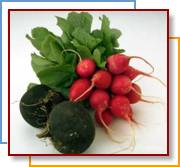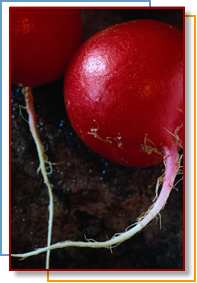
Radishes were first cultivated thousands of years ago in China, then in
Egypt and Greece. Radishes were so highly regarded in Greece that gold
replicas were made. The radish did not make its way to England until
approximately 1548. By 1629 they were being cultivated in Massachusetts.
Radishes are root vegetables that resemble beets or turnips in appearance
and texture, but have a distinct flavor. It is the root of a plant
classified in the mustard family.
In the United States radishes are usually eaten raw; however, they can be
added to cooked dishes or served whole. The biggest crops grown in the
United States come from California and Florida, but most states grow
radishes.
|
|
Radish |
Serving
size 1/2 cup, sliced (58g)
|
Amounts
Per Serving |
% Daily
Value |
| Calories
10 |
|
| Calories
from Fat 0 |
|
| Total Fat 0g |
0% |
| Saturated
Fat 0g |
0% |
| Sodium
25mg |
1% |
| Cholesterol
0mg |
0% |
| Total
Carbohydrate 2g |
1% |
|
Dietary Fiber 1g |
4% |
|
Sugars 1g |
|
| Protein 0g |
|
| Vitamin A |
0% |
| Vitamin C |
15% |
| Calcium |
2% |
| Iron |
2% |
* Percent Daily Values are based on a
2,000 calorie diet. |
|
| |
|
There are five main varieties of radishes.
Red Globe
This variety is the most popular in the United States and is the familiar
looking red and white radish. It is small, round or oval shaped, sometimes
referred to as "button" red radishes. They range in diameter from one to
four inches (most commonly closer to one inch) and have a solid, crisp,
flesh. Available year-round.
Black
This variety is turnip-like in size and shape, approximately eight inches
long. Black radishes have a dull black or dark brown skin. When peeled,
their flesh is white, quite pungent, and drier than other radishes. Black
radishes have a longer shelf-life than most radishes, so they are
available year-round, although the crop peaks in winter and early spring.
Daikons
This variety is native to Asia. They are very large, carrot-shaped
radishes that are up to 18 inches long and weigh one to two pounds.
Daikons have a white flesh that is juicy and a bit hotter than a red
radish, but milder than black. Available year-round, but are most
flavorful in fall and winter.
 White Icicles White Icicles
This variety is long, up to a half foot, and tapered. They have a white
flesh that is milder than the red variety. Generally available year-round.
California Mammoth White
A larger variety than the white icicle, these radishes have oblong-shaped
roots about eight inches long. Their flesh is slightly pungent. Generally
available year-round.
Radishes with their leaves intact are usually tied in bunches, while
topped radishes are sold in plastic bags. If the leaves are attached, they
should be crisp and green.
Whether red or white, roots should be hard and solid, with a smooth,
unblemished surface. Avoid soft or spongy radishes. Be sure to check
bagged radishes for mold before purchasing. Black radishes should be
solid, heavy and free of cracks. This variety is often found in Russian or
Polish neighborhood stores. Daikons, found most easily in Asian markets,
should be evenly shaped and firm, with a glossy, almost translucent sheen.
If radishes were purchased with the leaves attached, remove the tops
unless they will be served the same day. Place radishes in plastic bags,
if they are not already packaged, and store in the refrigerator. Most
varieties will keep up to two weeks in the refrigerator. Black radishes
can be stored for months if they remain dry; store them in perforated
plastic bags and keep in the refrigerator.
 Scrub radishes and trim off the stem end and tip. You may peel the
radishes or leave the skin intact. The skin is responsible for much of the
pungency, so the black radish is most often peeled for those not
accustomed to this variety. However, the red globe and white icicle
radishes are rarely hot enough to warrant peeling. Scrub radishes and trim off the stem end and tip. You may peel the
radishes or leave the skin intact. The skin is responsible for much of the
pungency, so the black radish is most often peeled for those not
accustomed to this variety. However, the red globe and white icicle
radishes are rarely hot enough to warrant peeling.
Small radishes can be served whole or chopped; while black and daikons are
usually cut or grated.
The most common uses for radishes are as a garnish or as an ingredient in
a green salad.
 Roasted Radishes and Root Vegetables Roasted Radishes and Root Vegetables
Serves 4
Each serving equals 2 cups of fruit or vegetables
Source: Radish Council
Ingredients
3 medium sweet potatoes, peeled and cut into 2-inch chunks (3 cups)
4 medium parsnips, peeled and cut into 2-inch, about 2 cups
2 medium red onions, peeled and quartered
12 oz. radishes
1 whole head of garlic, cut in half lengthwise
3 tablespoons olive oil
½ tsp. black pepper
1 Tbsp or 1 tsp dried thyme
Preheat oven to 450 F. In a 13x9x2 inch nonstick baking pan (or spray a
conventional pan with vegetable cooking spray) place mushrooms, bell
pepper, zucchini and onion. Toss with olive oil, garlic, salt and black
pepper. Bake uncovered, until mushrooms and vegetables are tender, about
20 minutes. Serve as a side dish, or toss with pasta or rice if desired.
Nutritional analysis per serving: Calories 342, Fat 8g, Calories from
Fat 22%, Protein 3g, Cholesterol 0mg, Fiber 5g, Sodium 300mg.

Find more in our
recipe database!
|



